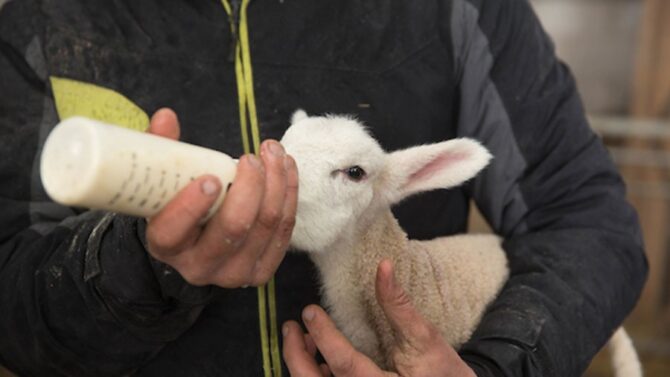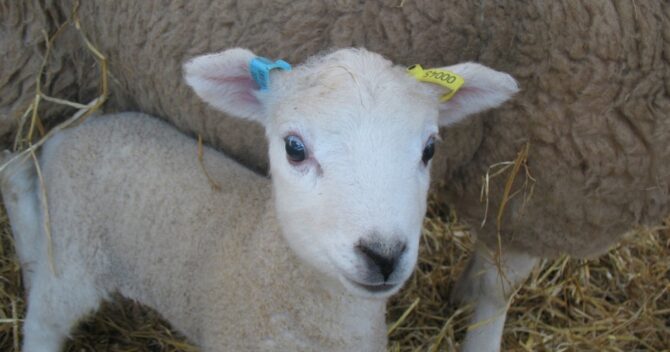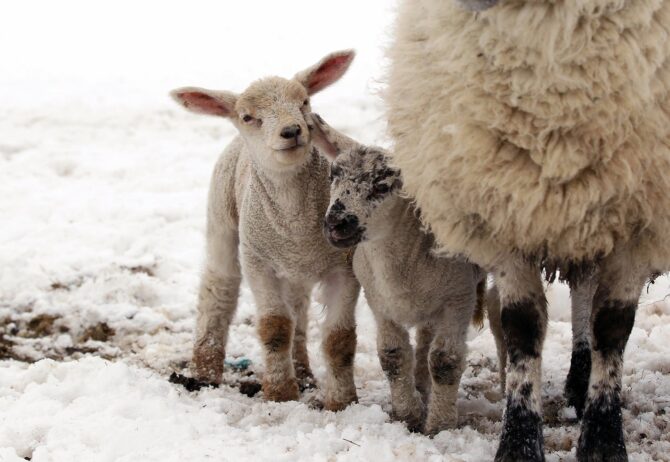Winter lambing brings its own set of challenges—bitter cold, wet bedding, frozen water troughs, and fragile newborns that need constant attention.
Unlike lambing in the milder spring months, raising lambs in winter demands more preparation, vigilance, and resources. But it also comes with some serious advantages, like stronger prices for early-season lambs and reduced parasite pressure.
The key is being proactive. Lambs are most vulnerable in their first hours of life, especially when temperatures drop below freezing.
One missed feeding or exposure to a cold draft can lead to hypothermia or worse. That’s why getting the basics right—like shelter, feeding, hygiene, and health checks—makes all the difference.
Whether you’re a small-scale homesteader or running a larger flock, these seven essential tips will help you navigate the toughest season and give your lambs the healthy start they need.
Key Highlights
- Warm, dry shelter is non-negotiable in subzero climates
- Colostrum within two hours of birth boosts survival
- Body temperature must be maintained carefully
- Extra nutrition is essential for both ewes and lambs
- Clean, dry bedding reduces disease risk
- Vigilance against illnesses like pneumonia is critical
- Good records help track issues before they escalate
1. Provide Warm and Dry Shelter

Cold stress is one of the leading threats to newborn lambs, especially in the first 48 hours after birth. At this stage, their ability to regulate body temperature is still developing, and even a slight drop can be life-threatening.
Make sure your lambing pens are:
- Well-insulated yet breathable to avoid humidity that can lead to pneumonia.
- Dry and draft-free, with straw piled deep enough to insulate against frozen ground.
- Equipped with supplemental heating, such as heat lamps, heating pads, or lamb warming boxes.
Some farmers build insulated “lambing jugs”—small, temporary pens for individual ewe-lamb pairs. These reduce competition and let you monitor bonding, feeding, and warmth more easily. Avoid direct exposure to metal walls or concrete floors, as these surfaces quickly sap heat from small lambs.
2. Ensure Colostrum Intake Within the First Few Hours

Colostrum is packed with maternal antibodies that protect newborn lambs against disease. It’s often referred to as “liquid gold” for a reason—it builds the foundation of a lamb’s immune system.
- Time matters: Lambs need colostrum within two hours, ideally even sooner, especially in freezing temperatures.
- If a ewe rejects her lamb or produces insufficient milk, use a bottle colostrum replacer or thawed, frozen colostrum from your freezer stash.
- Hand-feeding with a bottle or stomach tube may be necessary for weak lambs.
A practical trick many shepherds use is harvesting extra colostrum from high-producing ewes and freezing it in ice cube trays—easy to portion and defrost as needed.
3. Monitor Lamb Body Temperature Closely
Hypothermia can set in before you even realize it—especially if the lamb is born outside or on a cold surface. Cold lambs quickly stop nursing, which creates a dangerous spiral.
- A healthy lamb should have a rectal temperature of 102°F to 103°F (38.9°C to 39.4°C).
- If a lamb is below 100°F, warm it before attempting to feed—feeding a cold lamb can be fatal.
- Use infrared heaters, hot water bottles (wrapped in towels), or lamb warming boxes to bring them back to a safe temperature slowly.
Don’t underestimate the power of a dry towel and some vigorous rubbing—it mimics the ewe’s licking and improves circulation.
4. Boost Nutrition for Ewes and Lambs

Winter is no time to skimp on calories. Pregnant ewes need more energy to maintain their own body heat and support developing lambs.
- In the final 6 weeks of pregnancy, increase feed quality—add grains, beet pulp, or high-energy hay.
- Post-lambing, lactating ewes should get free-choice hay, and consider mineral supplements to support milk production.
- Introduce creep feeding for lambs at 2–3 weeks old—this allows them to eat solid food in a ewe-free space, reducing pressure on mom and encouraging early growth.
Tip: If your pastures are snow-covered, make sure fresh water is available and not frozen—hydration affects feed conversion and milk production.
5. Maintain Clean and Dry Bedding
A clean pen is more than just for comfort—it directly impacts health. Wet bedding contributes to navel infections, respiratory illness, and diarrhea.
- Layer bedding to insulate the ground and use lime, wood ash, or absorbent powder underneath to control moisture.
- Rotate and clean areas regularly, especially if housing multiple lambing ewes.
- Keep feeders and waterers off the ground to prevent contamination.
If lambs lie down in soiled straw, their navel cords are exposed to bacteria. This can lead to joint ill, a painful and sometimes irreversible infection in young lambs.
6. Protect Against Common Winter Illnesses

Colder months bring a higher risk of certain illnesses:
- Pneumonia thrives in damp, unventilated barns. Make sure airflow is sufficient without letting in drafts.
- Scours (diarrhea) can quickly dehydrate lambs. Use electrolytes to rehydrate, and isolate affected animals.
- Joint ill is linked to bacteria entering the navel—dipping navels in iodine right after birth helps prevent this.
Preventive steps:
- Follow a vaccination schedule for pregnant ewes (like CD&T).
- Disinfect equipment and wear gloves during assisted births or bottle feeding.
- Have medications like antibiotics or probiotics ready, especially if you live far from a vet.
7. Tag, Record, and Monitor Regularly

Record-keeping might not feel urgent in the moment—but it’s one of the best tools you have to spot trends and act early.
- Use ear tags or paint to identify lambs and match them to their mothers.
- Note birth weights, any treatments, feeding issues, and growth milestones.
- Weigh lambs weekly using a sling and spring scale—it helps catch underperformers before problems worsen.
If one lamb in a litter is significantly behind in weight or looks dull, early records help determine whether it’s a feeding issue, parasite load, or something else entirely.
Final Thoughts
This list is not exhaustive, but these practices are the backbone of successful winter lambing. You can go further—investing in waterproof coats for sheep, using insulated water buckets, or installing surveillance cameras for nighttime births—but if you get these main points right, you’re already ahead.
Winter lambing isn’t for the faint of heart. It’s demanding, cold, and occasionally chaotic—but it’s also incredibly rewarding. With extra attention to shelter, warmth, feeding, and cleanliness, your lambs can thrive despite the snow and wind. Being prepared, staying observant, and acting fast when issues arise will give your flock the best shot at a healthy, productive season.






